Purslane and its cultivation
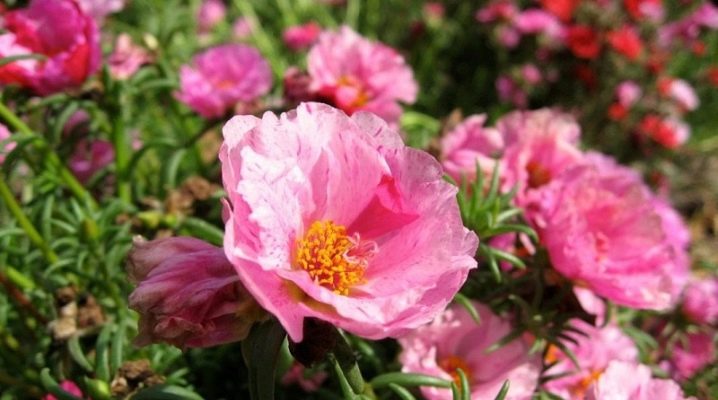
Questions about what a purslane looks like, where to plant a plant in a flower bed and whether it is possible to grow flowers from seeds regularly arise from summer residents who first encountered the mention of a popular garden culture. Wild perennial species and annual representatives of this thermophilic genus are found quite often in modern gardens.
Caring for purslane in the open field is simple, and the high decorativeness of the flower allows it to decorate alpine slides, mixed and individual plantings, frame paths, harmoniously combining undersized plants with the surrounding landscape.
general description
Purslane is a perennial plant in the wild, often grown as an annual in its garden form. The culture is thermophilic; South America is considered its homeland. Also found under the names "danduri", "rug", belongs to the Portulacov family.
The wild purslane looks like a herbaceous plant with a height of 10 to 30 cm. Forms a branched fusiform root system. The stems are predominantly creeping, rather thick and succulent, brown. Shoots also branch intensively, covered with ovoid green leaves.
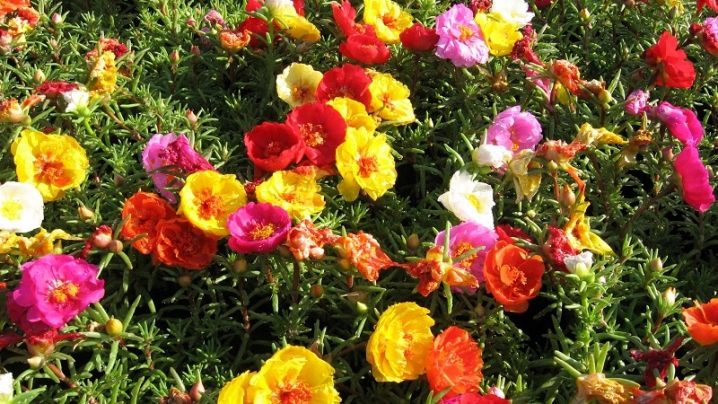
Purslane flowers are very diverse in their colors, they are:
- white;
- yellow;
- scarlet;
- orange;
- crimson;
- burgundy;
- dark brown.
Among cultivars, varieties with both a simple and a double corolla are widely represented. There are variants with variegated harlequin petals. Flowering occurs from June to September. Each bud blooms for 1 day. At the same time, 2-3 corollas are formed on the stem, at the end of flowering, a fruit-box with seeds inside is formed. In its wild-growing form, purslane is not considered a valuable plant, it is often perceived as a weed. The plant does not have sufficient decorative effect, but it quickly fills the space due to its self-seeding ability. In nature, it is most common in Central Asia, Transcaucasia, South America, in Russia it is found in the Far East. Ornamental varieties are grown in China, Japan, and European countries.
Purslane is an edible plant. Leaves and young shoots harvested before the beginning of the flowering period are eaten. They are boiled, stewed in oil, served as a side dish.
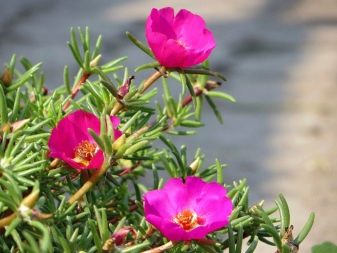
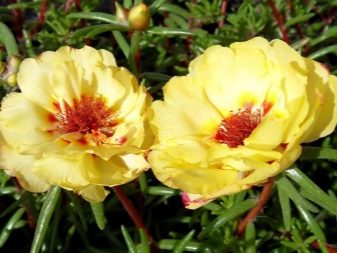
Views
Perennial wild purslane is of little interest to gardeners. Its decorative properties are minimal, but edible vegetative shoots can be used for food. Annual varieties (decorative, bright, varietal and terry) are much more diverse. Among the species worth noting are the following options.
- Garden. Wild-growing subspecies with thick oval leaf plates and creeping stems, raised by a lush rosette up to 60 cm in height. The color of the shoots is lighter than that of cultivated subspecies, the plant is considered a valuable medicinal raw material, its young parts are edible as a side dish or spice. Among the popular varieties are "Macovei", "Firefly", "Paradox".
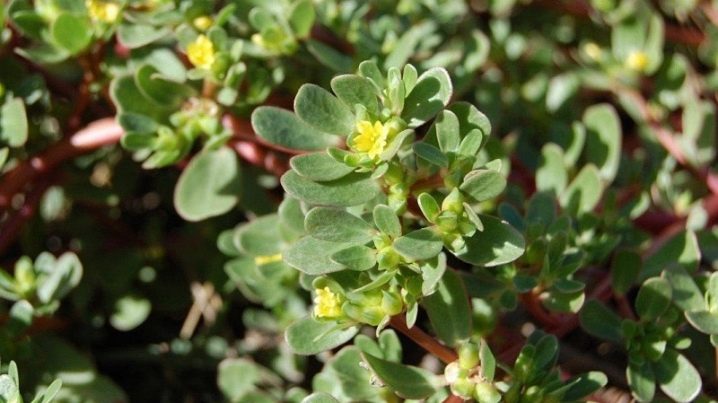
- Large-flowered. The most spectacular look, especially popular with gardeners. Plants do not exceed 30 cm in height, have fleshy creeping stems.The diameter of the variegated flowers reaches 50 mm; in sunny weather, they open up, demonstrating all their magnificence. It is customary to sow this type of purslane, mixing varieties with different shades of petals in one flower bed.
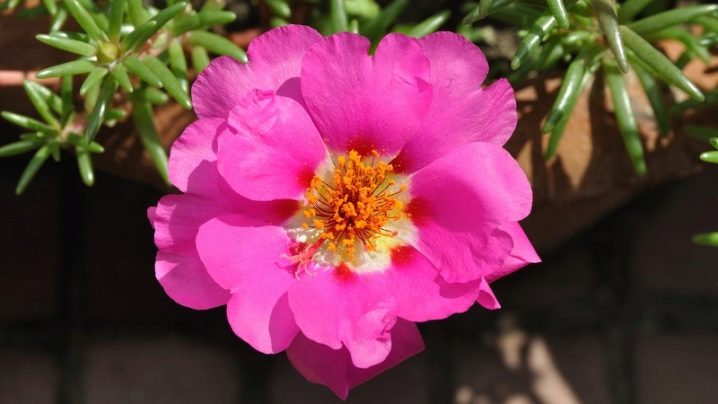
- Ampelny. A hybrid characterized by elongated drooping shoots. Designed for growing in hanging pots on a perennial basis or outdoors in an annual cycle. The bush grows up to 40 cm in diameter. Its shoots are strong and long, and the flowers can be either simple or double.

- White-flowered. Shrub variety up to 40 cm high, has a high growth rate. Blooms in a month after germination. Inflorescences are always double, pure snow-white or delicate cream color. Outwardly, lush buds are a bit pink.
Each variety has its own characteristics and advantages. For decorating the site and for the first growing experience, seed mixtures are suitable, allowing you to get a bright floral carpet that combines plants with different shades of petals.
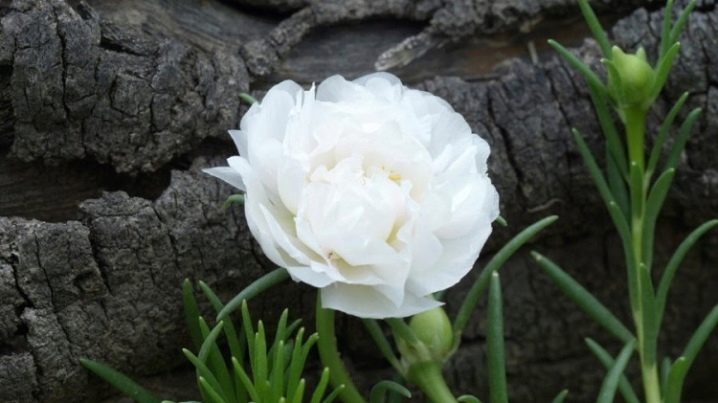
Landing
Purslane is easiest to plant by seeds in containers and pots, flowerpots, as well as by direct sowing in open ground. In greenhouses, sowing begins in February-March. It is better to place seeds on a flower bed after increasing daylight hours, in April. You can plant a purslane in a pot on a windowsill with installed phytolamps almost at any time of the year. The soil for the plant is selected not too acidic, ready-made peat mixtures are not particularly suitable for growing purslane.
It is better to make the substrate yourself based on garden or garden soil and sand, added in a volume of about 20%. All ingredients are mixed and disinfected in the oven. When grown in pots and flowerpots, the bottom of the container is drained with pebbles or expanded clay to avoid stagnant water. A layer of soil is placed on top, slightly compacted, well moistened. Seeds are taken not freshly harvested, but lying at least 6 months. It is optimal to collect or purchase them in the summer for spring sowing.
The order of planting purslane in this case will be as follows.
- Making grooves about 0.5 cm deep.
- Sowing seeds at intervals of 10 mm. They are slightly covered with soil substrate.
- Soil spraying.
- Pulling on the film cover. Under it, the seedlings are kept at temperatures above +22 degrees for a week.
With the emergence of seedlings, the film is removed, while continuing to maintain a high temperature. When sowing early in the garden, care should be taken to create a greenhouse before warming. Until that time, for 1-2 hours a day, the film is slightly opened for airing. The shelter is completely removed only with the establishment of the atmospheric temperature not lower than +25 degrees. They dive and thin out the plantings after the appearance of 2 true leaves. There should be no more than 3 plants per pot. They are transferred to the flower bed when the stem reaches a height of 20-30 mm.
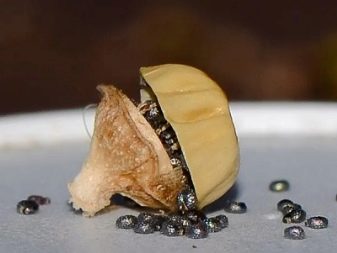

Growing care
In the open field (in a flower bed, in a flower garden), purslane requires minimal maintenance. But when cultivating it in a flowerpot or in a pot on the balcony or windowsill, you will have to make more effort. As soon as the purslane emerges, it has to provide a high intensity of light so that the stems do not stretch out. Special lamps will help to grow beautiful flowers from seeds, as well as placing containers with them near sources of natural light.
Seedlings of purslane grow well only at atmospheric temperatures above +10 degrees. At the same time, it is important to regularly and thoroughly water and feed it. Perennial winter species necessarily protect from the cold.
It is important to drain the soil well so that water does not stagnate in it, especially when its underground reserves are located nearby. Flowers are not afraid of bright sunlight, they should be placed outside shady areas, in open areas.
Watering and feeding
Purslane is a moisture-loving plant that requires weekly watering in dry weather. When natural precipitation falls in sufficient quantity, irrigation is carried out less frequently. In a flower bed, the culture most often forms a dense cover carpet, covering the soil. Loosening the soil, weeding it is not required in this case. Care should be taken with feeding too. An excess of nitrogen and other nutrients in the soil leads to an abundant build-up of green mass.
In this case, you can not wait at all for flowering. Purslane grows successfully even on poor sandy soils, while buds are abundantly formed on its shoots. Seedlings for seedlings need feeding, in contrast to adult plants. The first time fertilization is applied on the 14th day after the pick. Nitrogen is used, which is necessary for the culture to gain green mass. Before transferring to open ground or the beginning of flowering, the bushes are fed with mineral complexes based on potassium and phosphorus.
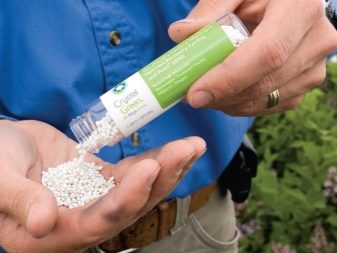
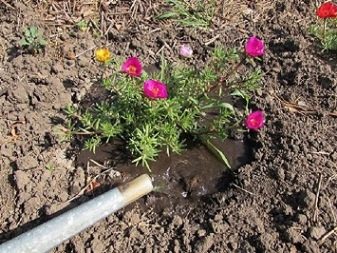
Wintering
Growing as a perennial in the middle lane can only withstand the garden purslane. The rest of the species are sown in an annual cycle, collecting seeds in capsules in autumn after flowering. Then the site is dug up, the remains of the plants are disposed of. Due to the high ability to self-seeding in spring, seedlings of purslane are sometimes found in the same places.
If you want to keep the bushes as adults, they can be carefully dug up together with an earthen lump, and then moved to pots or flowerpots until spring. Placing them on a southern and well-lit windowsill will help to maintain their flowering in winter.
Reproduction
The main way that purslane reproduces in nature is generative (self-seeding from capsule fruits). It is the seeds collected independently or purchased in packaging that allow you to get new plants in a one-year cultivation cycle.
In regions with warm climates, purslane can be grown as a perennial. In this case, it is propagated by cuttings, cutting them off from an adult bush. The bottom of the branches obtained is treated with a growth stimulant, then they are placed in a loose mixture of sand and earth until rooting. During this period, you can cover the cuttings with a translucent container to protect them from wind and bad weather. After the appearance of young shoots and leaves on the branches, you will need to wait 2-3 weeks, and then transplant the plant to a permanent place.

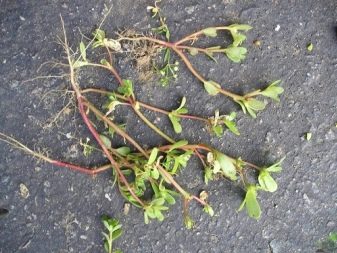
Diseases and pests
Purslane is not one of the plants that are intensively affected by diseases and pests. The culture is naturally well protected from insect attacks. But with high soil moisture, the roots can rot. Quite rarely, the culture is affected by spores of the fungus Albugo portulaceae. Germinating in the tissue of purslane, it causes deformation of shoots, leaf spot. Treatment and prevention of diseases are carried out using chemical fungicides. Means such as Bordeaux liquid, copper sulfate are suitable.
Application in landscape design
Purslane, which belongs to ground cover plants, is considered one of the best decorations for garden plots. Landscape designers use it in the design of vacant lots, giving them a decorative effect, covering areas with poor soils. In open flower beds under the scorching sun, he becomes a real salvation, bringing bright colors to the decor of the most lifeless territories.
Creating a spectacular lawn interspersed with wild herbs, you can pay attention to terry purslane varieties. Plants with simple flowers will harmoniously fit into the aesthetics of an alpine slide, rockery. At home, flowers are planted as annuals in pots and containers. In ampelous culture, they are grown by replanting 1 time in 4 years, achieving year-round budding.
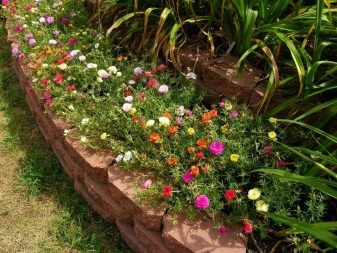
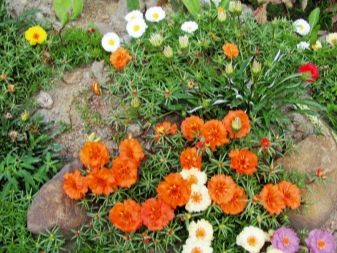
Professional landscape designers often use different types of purslane when creating the following ideas.
- Laconic paired or single flower beds. You can plant monochrome varieties or use a mix of yellow and orange, red and white buds.
- Cascading compositions.Here, a solid carpet of creeping plants is placed in the foreground, framing it with higher crops.
- Zoning elements. Of course, purslane is not planted as a hedge. But it looks spectacular in the frame of the borders, harmoniously decorates the paths.
By combining different types of plants with each other, you can achieve a harmonious garden design. Early daffodils and tulips, phlox will help to dilute the flower bed. The mixture on the lawn is formed by grasses and cereals. Hosts and juniper bushes stand out elegantly against the background of a solid carpet.
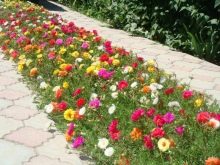
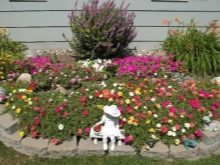
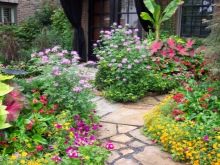








The comment was sent successfully.